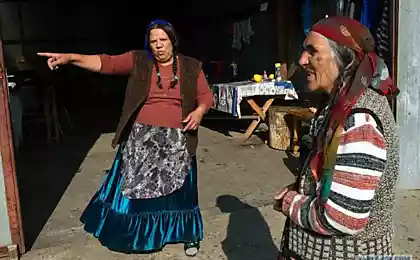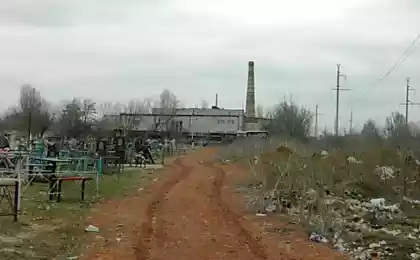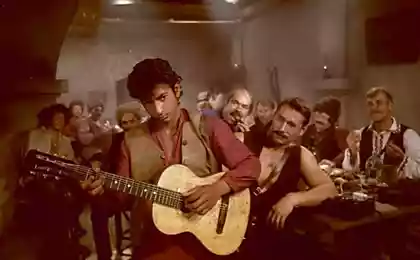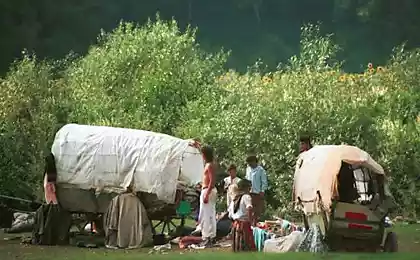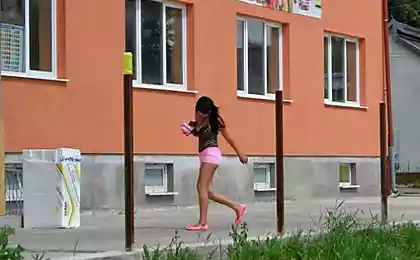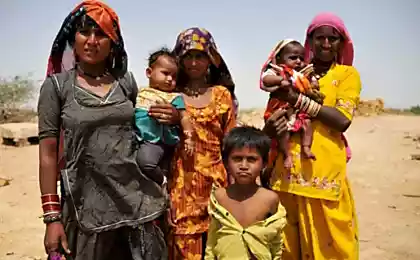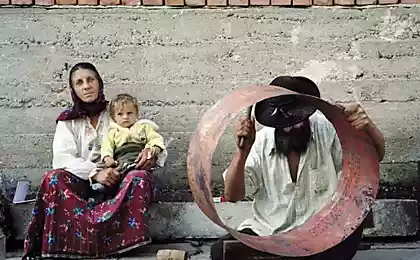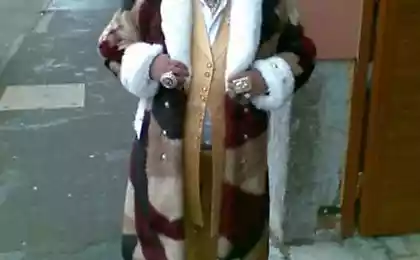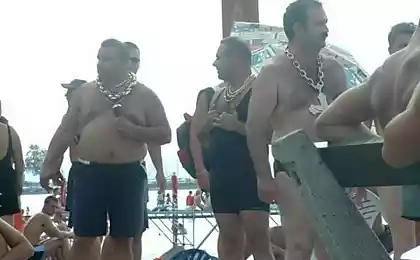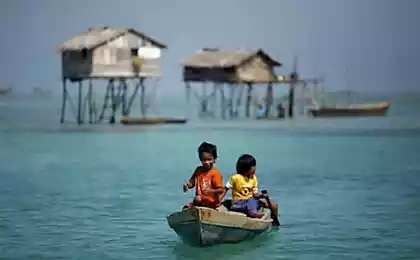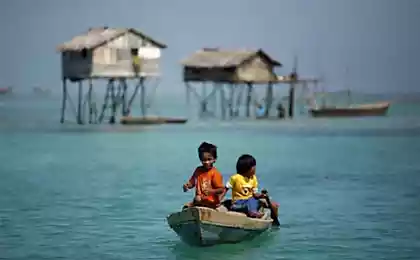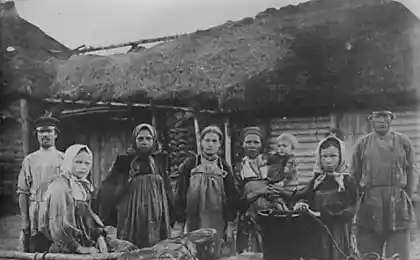1381
Life of Romanian gypsies
Commentary photographer Jeremy Sutton-Hibbert: "From 1990 to 2006, I photographed the camp Sintesti Roma in Romania, documenting the life, traditions, history and views of the Romanian gypsies.
My photos convey a period of dramatic change in the camp - its residents leave the dark past of the communist years and go back on the path to material wealth, access to which can give new possibilities.
The camp has gradually turned from a cluster of houses and traditional tents, horses and carts to the village, where the entire income (earning from the sale of scrap metal) is spent on the construction of buildings and purchase of fantastic cars of Porsche. However, the outlook of people has changed, women still do not provide education and opportunities to work, and a desire to express themselves and be "Europeanised" haunted ».
22 Photo © Jeremy Sutton-Hibbert
1. Nanika Stanescu (right) jokes with a family member during the Passover celebration in the camp of Roma Sintesti. (Jeremy Sutton-Hibbert)
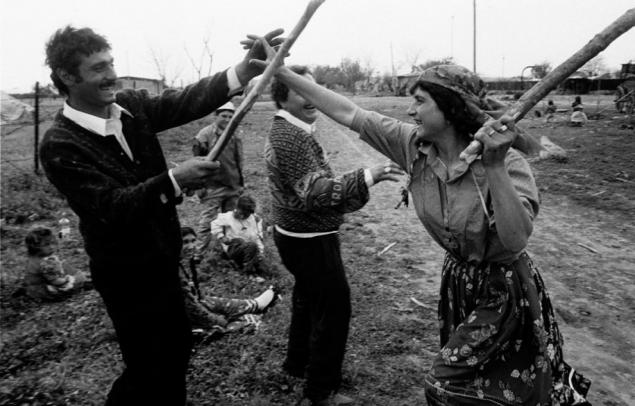
2. Gypsy Papusha Mihai fell asleep with her daughter Garoafoy after breastfeeding. On the table leftover food after the celebration of Easter - the most important holiday in the calendar of the Romanian Roma. (Jeremy Sutton-Hibbert)
3. Youth Roma come with horses on the road to the camp Sintesti, near Bucharest. In the camp of the horses usually looks young. (Jeremy Sutton-Hibbert)
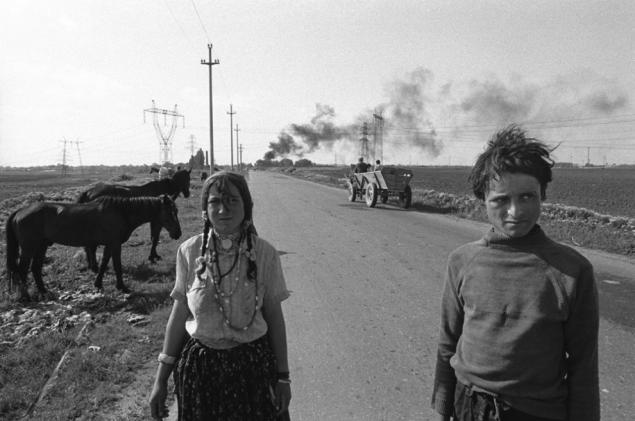
4. Girls Bikers Calderara in his one-room house in a gypsy camp Sintesti. (Jeremy Sutton-Hibbert)
5. Romanians, gypsies hired, waiting among the metal until the stove metal alloy, which is why over the gypsies hangs a black cloud of smoke. (Jeremy Sutton-Hibbert)
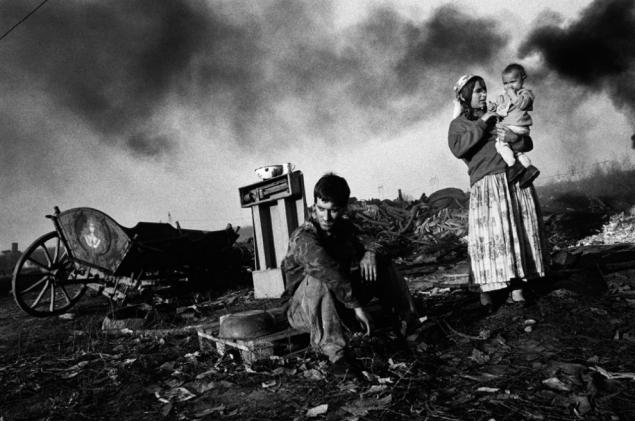
6. The funeral of 4-year-old Florin Michael, who died of meningitis in the camp of Romanian Roma in Sintesti. His family is poor and barely able to pay for the funeral. Florine was buried in his beloved cap with flowers and money. According to tradition, the Romanian Orthodox priest pours beer onto the coffin, reciting prayers for the repose. (Jeremy Sutton-Hibbert)
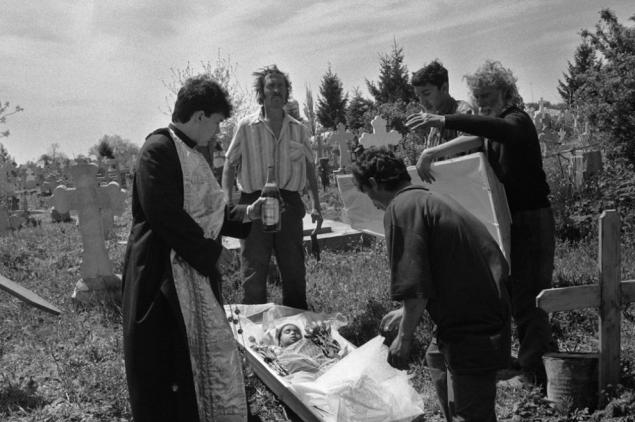
7. Easter - one of the most important holidays in the calendar of the Romanian Orthodox Church. Zambia Michael and her brother Puia (hands in his pockets) are close to the wagon with food, drinks and gifts to the house of his grandfather. In the background are two unfinished mansion. (Jeremy Sutton-Hibbert)
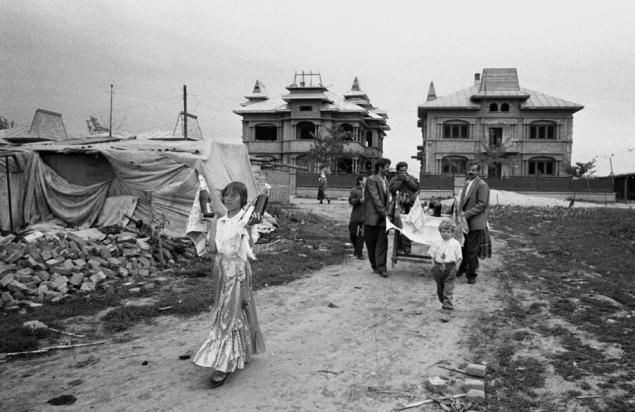
8. Goeth (front) and Papusha Michael (second) with her mother (back) and daughter Garoafoy make soap in a can. (Jeremy Sutton-Hibbert)
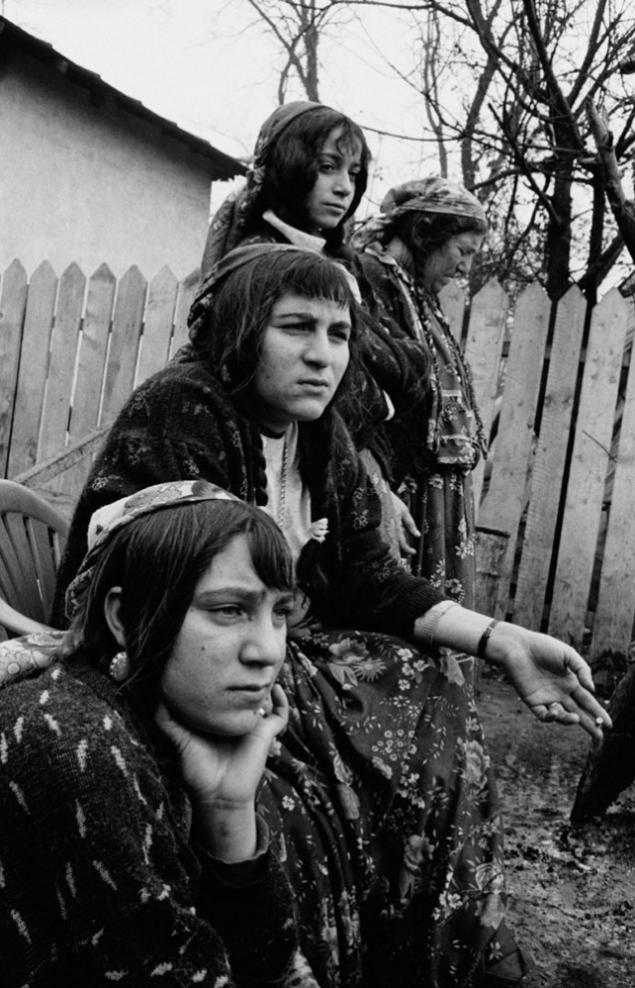
9. Romanian Gypsies on the road to the camp Sintesti, near Bucharest. The photo was taken in 1993. Now on this road are many mansions, built not on architectural design, and in dreams. (Jeremy Sutton-Hibbert)
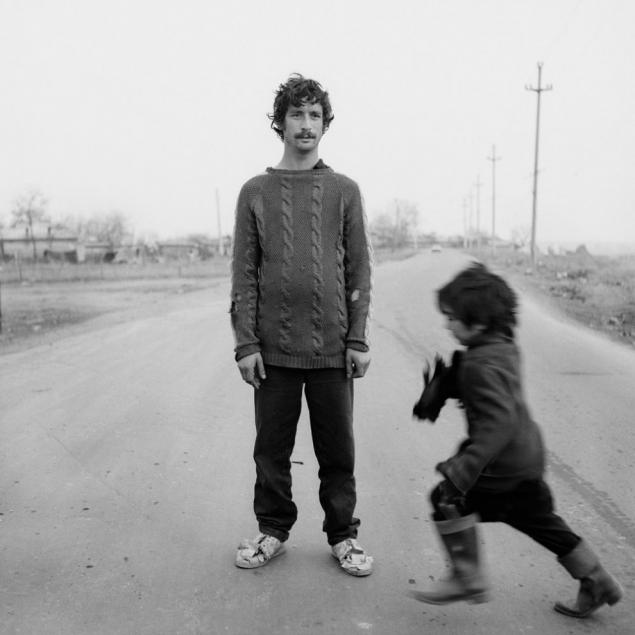
10. Talia Michael, head of the camp Sintesti mother, tells the tale to his granddaughter Garoafe family tent. (Jeremy Sutton-Hibbert)

11. The girl and her baby are at home in the gypsy camp Sintesti. (Jeremy Sutton-Hibbert)
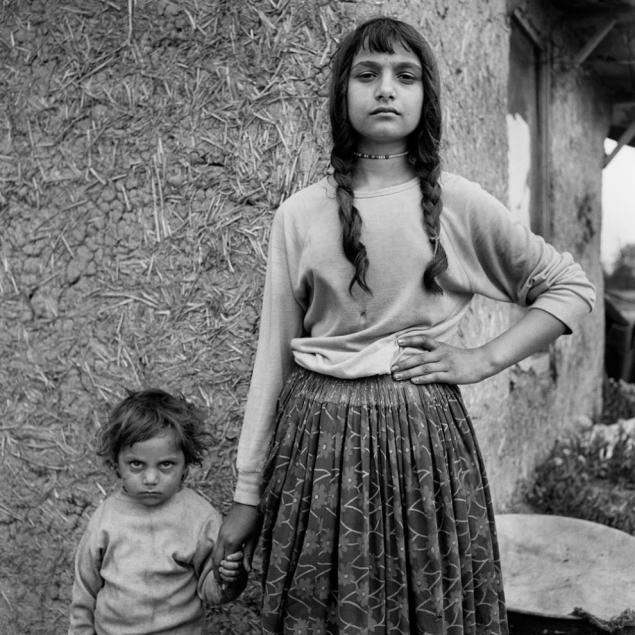
12. Roma girl named Mia standing in front of a mermaid painted on the wall in the old camp. Mermaids - popular decorating the walls, though no one knows when and who first drew them. (Jeremy Sutton-Hibbert)
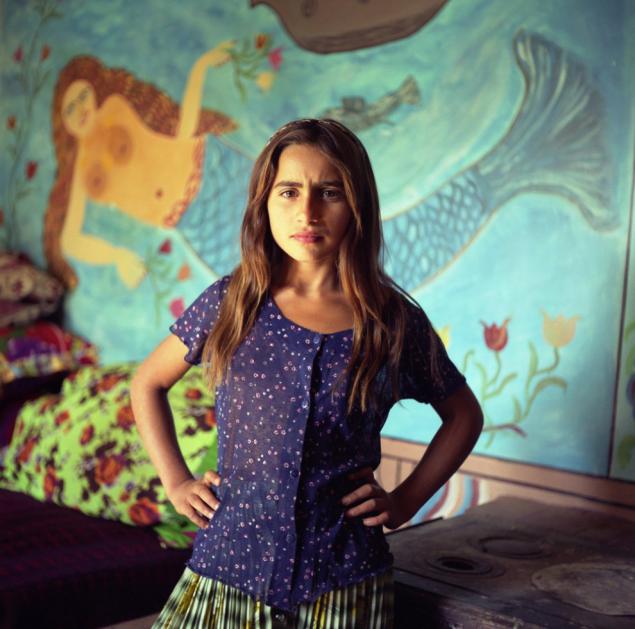
13. 14-year-old married girl Gradina Badea that her family called "talibkoy" because dark skin, standing in fake T-shirt Dolce and Gabbanna in the house where she lives with her large family. (Jeremy Sutton-Hibbert)
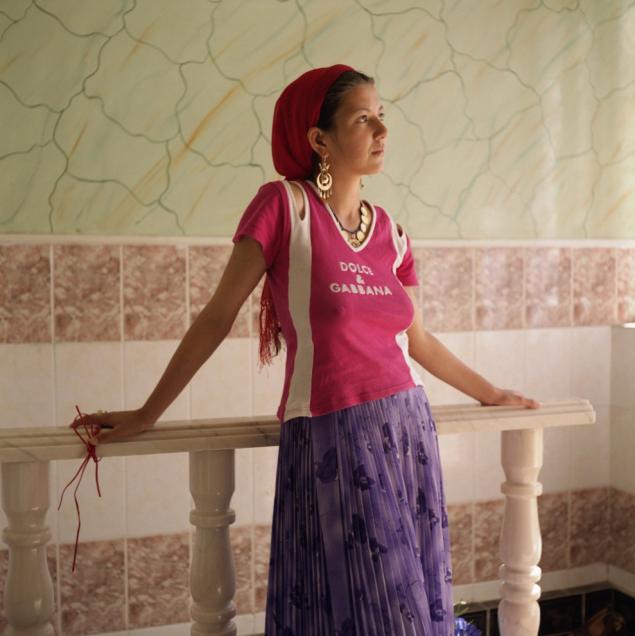
14. The view of the main road through Sintesti of the jeep «Porsche Cayenne». The men of the village like German cars, considering them better than others. And if they can not drive a car, because they do not know how to read and write, they hire drivers. 16 years ago on both sides of the road were fields now are expensive mansions and luxury cars drive on the same roads as the traditional horse-drawn carts. The Roma have traditionally engaged in the collection and processing of scrap metal, once there made distillation apparatus, pots and pans, but now the main source of income - scrap metal. Revenue from this industry went to the construction of large houses in the village Sintesti, 20 km from Bucharest, as well as the purchase of Western cars such as «BMW», «Mercedes» and «Porsche». (Jeremy Sutton-Hibbert)
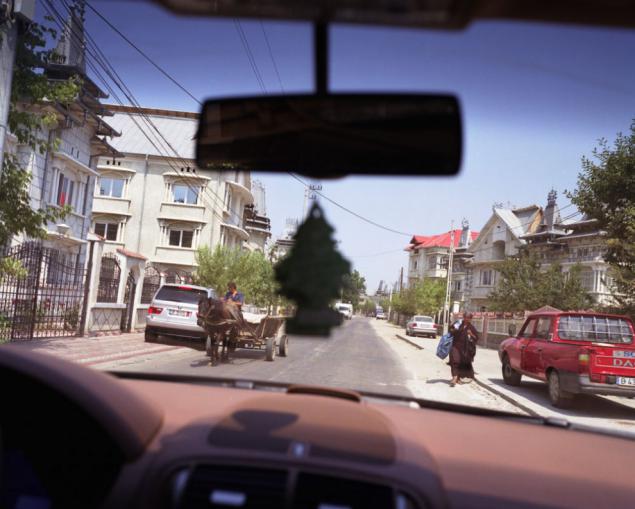
15. Scrap metal collected in the garden before being sold to the foundry. (Jeremy Sutton-Hibbert)
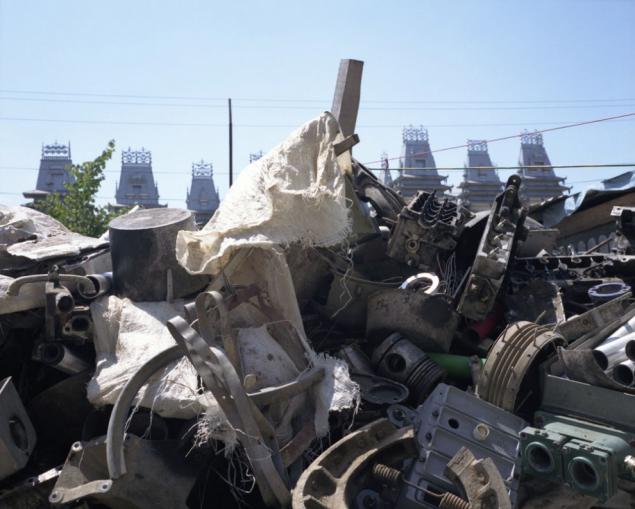
16. When not in use the computer at home in the Gypsy camp Sintesti. Computer was purchased in order to have access to the London Stock Exchange for the price of the metal. Computer nobody uses because of the lack of knowledge of the Internet and how to use it. (Jeremy Sutton-Hibbert)
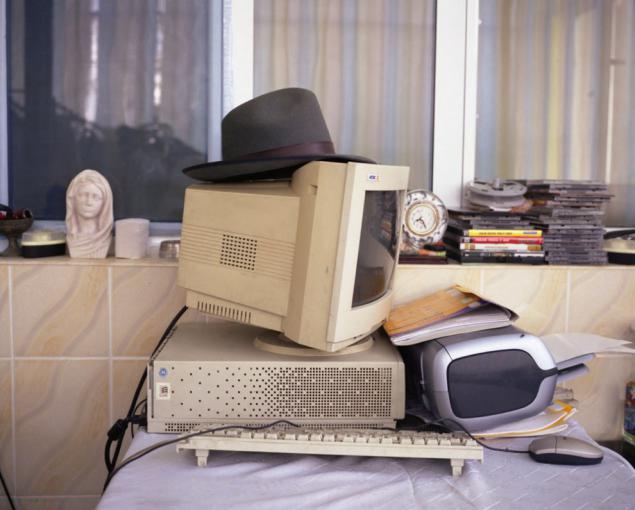
17. 18-year-old Radu Toma sitting in the living room of her new home in the Gypsy settlement Sintesti. (Jeremy Sutton-Hibbert)
17. 18-year-old Radu Toma sitting in the living room of her new home in the Gypsy settlement Sintesti. (Jeremy Sutton-Hibbert)

19. Isabella Mihai bored on the couch, which is part of the dowry for her older sister Garoafy that marries 13-year-old Lulu in the town of Florina Sintesti. Dowry Garoafy brought from home, on the road to put on public display. At the wedding of about 100 pigs slaughtered a total value of $ 30 000. On Garoafe was a golden "salbe" - a necklace of gold coins worth about 30 thousand dollars. (Jeremy Sutton-Hibbert)

20. 14-year-old Mihai Garoafa dancing in the street with his father Gogoai Lulu at the wedding. Her husband was 13-year-old Florin Lulu. (Jeremy Sutton-Hibbert)
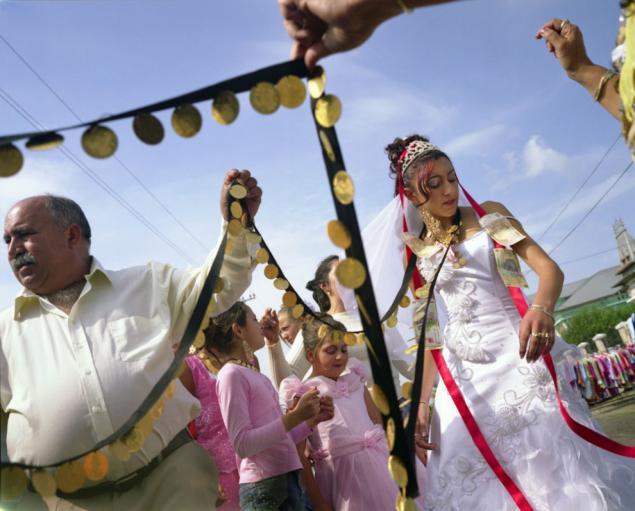
21. Gypsy dancing in the street, lit only by truck driving through, on their wedding day 14 years Garoafy Michael. (Jeremy Sutton-Hibbert)
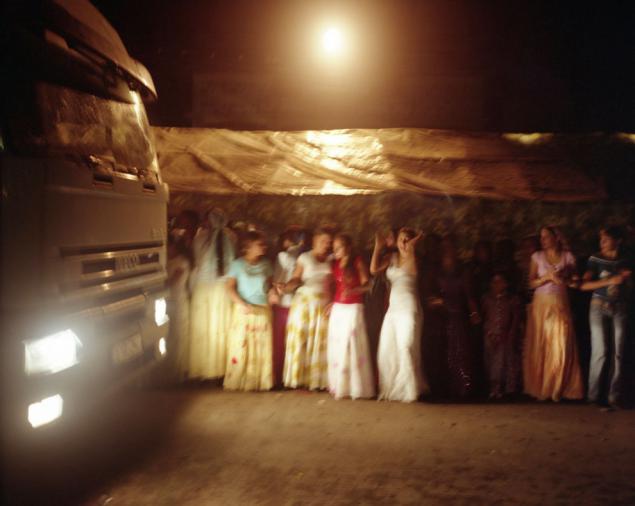
22. A piece of the plane with the word "Europe" is a tree in the village Sintesti. (Jeremy Sutton-Hibbert)

Source:
My photos convey a period of dramatic change in the camp - its residents leave the dark past of the communist years and go back on the path to material wealth, access to which can give new possibilities.
The camp has gradually turned from a cluster of houses and traditional tents, horses and carts to the village, where the entire income (earning from the sale of scrap metal) is spent on the construction of buildings and purchase of fantastic cars of Porsche. However, the outlook of people has changed, women still do not provide education and opportunities to work, and a desire to express themselves and be "Europeanised" haunted ».
22 Photo © Jeremy Sutton-Hibbert
1. Nanika Stanescu (right) jokes with a family member during the Passover celebration in the camp of Roma Sintesti. (Jeremy Sutton-Hibbert)

2. Gypsy Papusha Mihai fell asleep with her daughter Garoafoy after breastfeeding. On the table leftover food after the celebration of Easter - the most important holiday in the calendar of the Romanian Roma. (Jeremy Sutton-Hibbert)
3. Youth Roma come with horses on the road to the camp Sintesti, near Bucharest. In the camp of the horses usually looks young. (Jeremy Sutton-Hibbert)

4. Girls Bikers Calderara in his one-room house in a gypsy camp Sintesti. (Jeremy Sutton-Hibbert)
5. Romanians, gypsies hired, waiting among the metal until the stove metal alloy, which is why over the gypsies hangs a black cloud of smoke. (Jeremy Sutton-Hibbert)

6. The funeral of 4-year-old Florin Michael, who died of meningitis in the camp of Romanian Roma in Sintesti. His family is poor and barely able to pay for the funeral. Florine was buried in his beloved cap with flowers and money. According to tradition, the Romanian Orthodox priest pours beer onto the coffin, reciting prayers for the repose. (Jeremy Sutton-Hibbert)

7. Easter - one of the most important holidays in the calendar of the Romanian Orthodox Church. Zambia Michael and her brother Puia (hands in his pockets) are close to the wagon with food, drinks and gifts to the house of his grandfather. In the background are two unfinished mansion. (Jeremy Sutton-Hibbert)

8. Goeth (front) and Papusha Michael (second) with her mother (back) and daughter Garoafoy make soap in a can. (Jeremy Sutton-Hibbert)

9. Romanian Gypsies on the road to the camp Sintesti, near Bucharest. The photo was taken in 1993. Now on this road are many mansions, built not on architectural design, and in dreams. (Jeremy Sutton-Hibbert)

10. Talia Michael, head of the camp Sintesti mother, tells the tale to his granddaughter Garoafe family tent. (Jeremy Sutton-Hibbert)

11. The girl and her baby are at home in the gypsy camp Sintesti. (Jeremy Sutton-Hibbert)

12. Roma girl named Mia standing in front of a mermaid painted on the wall in the old camp. Mermaids - popular decorating the walls, though no one knows when and who first drew them. (Jeremy Sutton-Hibbert)

13. 14-year-old married girl Gradina Badea that her family called "talibkoy" because dark skin, standing in fake T-shirt Dolce and Gabbanna in the house where she lives with her large family. (Jeremy Sutton-Hibbert)

14. The view of the main road through Sintesti of the jeep «Porsche Cayenne». The men of the village like German cars, considering them better than others. And if they can not drive a car, because they do not know how to read and write, they hire drivers. 16 years ago on both sides of the road were fields now are expensive mansions and luxury cars drive on the same roads as the traditional horse-drawn carts. The Roma have traditionally engaged in the collection and processing of scrap metal, once there made distillation apparatus, pots and pans, but now the main source of income - scrap metal. Revenue from this industry went to the construction of large houses in the village Sintesti, 20 km from Bucharest, as well as the purchase of Western cars such as «BMW», «Mercedes» and «Porsche». (Jeremy Sutton-Hibbert)

15. Scrap metal collected in the garden before being sold to the foundry. (Jeremy Sutton-Hibbert)

16. When not in use the computer at home in the Gypsy camp Sintesti. Computer was purchased in order to have access to the London Stock Exchange for the price of the metal. Computer nobody uses because of the lack of knowledge of the Internet and how to use it. (Jeremy Sutton-Hibbert)

17. 18-year-old Radu Toma sitting in the living room of her new home in the Gypsy settlement Sintesti. (Jeremy Sutton-Hibbert)
17. 18-year-old Radu Toma sitting in the living room of her new home in the Gypsy settlement Sintesti. (Jeremy Sutton-Hibbert)

19. Isabella Mihai bored on the couch, which is part of the dowry for her older sister Garoafy that marries 13-year-old Lulu in the town of Florina Sintesti. Dowry Garoafy brought from home, on the road to put on public display. At the wedding of about 100 pigs slaughtered a total value of $ 30 000. On Garoafe was a golden "salbe" - a necklace of gold coins worth about 30 thousand dollars. (Jeremy Sutton-Hibbert)

20. 14-year-old Mihai Garoafa dancing in the street with his father Gogoai Lulu at the wedding. Her husband was 13-year-old Florin Lulu. (Jeremy Sutton-Hibbert)

21. Gypsy dancing in the street, lit only by truck driving through, on their wedding day 14 years Garoafy Michael. (Jeremy Sutton-Hibbert)

22. A piece of the plane with the word "Europe" is a tree in the village Sintesti. (Jeremy Sutton-Hibbert)

Source:



